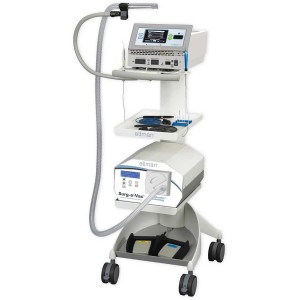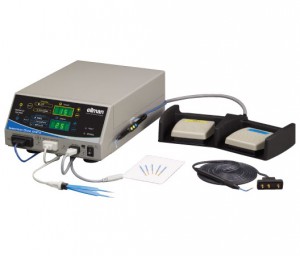The Principles of 4MHz Radio Wave Technology by Ellman
There is a relationship between the frequency used and the resistance of the tissue to its energy. High frequency, used in Ellman’s Radio Surgery, has a lower resistance to tissue and produces less penetration than low frequency electrosurgery.
This means that less heat is generated in the tissue. The low frequency used in electrosurgery meets the higher resistance of the tissue and produces greater penetration at its level. That is, it generates more heat, leading to greater cellular destruction / necrosis throughout the incision.
Advantages of the procedure:
- Very fine incision;
- Minimal lateral heat;
- Minimal cellular destruction;
- Ideal for soft tissue incisions and biopsies;
- Very good aesthetic results;
- Fast healing.
What can be treated with radiosurgery?
With this procedure we can treat with excellent results small/medium/large skin lesions such as:
- papillomas
- Genital warts
- Seborrheic keratoses
- Warts
- Benign vascular tumors (angiomas, angiofibromas, angiokeratomas, etc.)
- Sebaceous adenomas
- Hidradenoamas
- Siringoamas
- Moluscum contagiosum
- Fibromas, etc
Very good aesthetic results can be obtain also removing the en dome moles, which on the dermatoscopic examination are benign. They are removed by the shaving method and mandatory examined histopathologically.
Is the procedure painful?
Treatment involves low temperatures, with minimal thermal injury on the tissue, so in the case of minor lesions, it can only be enough to apply a topical anesthetic. In the case of larger lesions, local injection anesthesia is performed so that the procedure is comfortable for the patient.
After the procedure:
- Avoid prolonged contact with water;
- Local treatment according to the directions of the dermatologist.
Clinical Benefits for 4.0 Mhz Radio Technology:
- Rapid recovery – Less thermal damage to the tissue, healing is faster and patients recover with a high quality scar;
- Postoperative pain minimized;
- Fewer postoperative traces – Low temperature leads to reduced thermal damage to the tissue and rapid scarring, with very good aesthetic results;
- Fewer burns in tissue – Radiation minimizes burning of tissues as opposed to laser surgery or electrosurgery.
 Română
Română  English
English 




